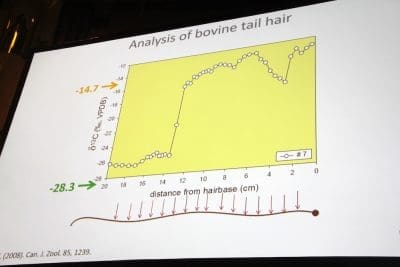TECHNOLOGIES are providing some exciting new possibilities to authenticate meat products and protect against substitution and counterfeiting.
 Meat provenance and food fraud was the theme for the opening session of the 2018 at the International Congress of Meat Science and Technology held in Melbourne yesterday. Almost 500 meat scientists from 43 countries attended the event, held in Australia for the first time in 30 years.
Meat provenance and food fraud was the theme for the opening session of the 2018 at the International Congress of Meat Science and Technology held in Melbourne yesterday. Almost 500 meat scientists from 43 countries attended the event, held in Australia for the first time in 30 years.
Irish meat scientist Prof Frank Monahan, from University College Dublin, outlined research into the use of isotopes and other ‘tracers’ in meat, to provide assurances about geographic origin, and dietary background in meat protein.
Both have obvious implications for premium beef brand program protection, particularly in markets where risk of substitution and counterfeit are high.
“Why is authentication of meat products important? It’s about consumer confidence about meat produced in a particular way or in a particular region,” Prof Monahan said.
For producers, it was about protecting those high-value products such as brands making grassfed, organic or regional claims from substitution and counterfeiting.
While much of his early research had focused on how animal production systems impacted the visual and sensory qualities of meat, more recently, Prof Monahan has started ‘looking from the other direction,’ – looking at the beef or lamb itself, to see what could be determined about the production system or geographical origin from which it came.
“We started to look for tracers within the meat that give an indication of the dietary background and region of origin. It works on the premise that animals are what they eat: what they consume gets deposited in the meat in some way, in the form of different molecules. Even gene expression is affected by the diets animals consume.”
Stable isotopes and trace elements are two such ‘signatures’ that have been examined, for analysing both dietary background and geographical origin. Spectroscopic analysis could provide a ‘fingerprint’ for meat samples for both.
Stable isotopes based on elements like hydrogen, carbon nitrogen oxygen and sulphur are naturally occurring elements in the foods we (and animals) eat, Prof Monahan said.
“What we are interested in, from an authentication perspective, is the ratio of heavy to light versions of the isotopes – for carbon, nitrogen, hydrogen and so on – that can be affected by the food and water consumed by the animal,” he said.
Different feedstuffs produced different carbon ratios. In the case of nitrogen, ratios were affected by the use of natural versus artificial fertilisers, for example. Hydrogen and oxygen isotope ratios tended to be good geographical indicators. There were challenges in this field, however – such as seasonal effects, with values changing at certain times of year; dietary switches through the year; and the trade in animal feedstuffs from region to region and country to country.
Prof Monahan provided some illustrations of how this isotopic information might be used for authentication in grassfed beef programs, for example.
One trial compared samples from four groups of animals on pasture, on concentrated rations, and two ‘intermediate’ groups fed both, or rotated. The ratios in the feed showed distinct differences in both carbon and nitrogen isotopes between grassfed and concentrate-fed animals, with the intermediate groups in between.
Prof Monahan said there were some challenges in this area, however, such as terminology used in Europe to describe different products, such as ‘pasture finished,’ ‘pasture based’ ‘forage fed’ and even ‘percentage grassfed’, which could lead to some confusion. In the US, the US Department of Agriculture produced a definition for grass/forage fed claims in 2007, only to withdraw it later when USDA decided it could not set or regulate such a claim.
“That does not mean that beef cannot be produced to this definition, it just means that this particular USDA claim cannot be used. What now happens is that producers apply to the USDA with developed documentation for a particular approval for their product, such as grassfed.”
Prof Monahan said the reality was that many so-called grassfed or percentage grassfed claims fell short of public expectations.
He suggested there would be even more discussion on the topic in future. Last month, an Irish butter producer using ‘from grassfed cows’ claims faced a US lawsuit over the claims. The same could be the case of beef and other meats in the future.
“That’s where the challenge is: how much substitution can we detect, if it is there?” Prof Monahan said.
It also raised questions about how quickly meat or muscle responded to a change in diet. One trial suggested the turnover was slow, up to 150 days for the carbon isotopes to ‘turn over’ to reflect the diet change.
Hair samples provide clear historic record
However the good news was that other parts of the animal, such as hooves and hair, were useful, because they contained a ‘dietary archive.’

Click on image to enlarge
If a tail-hair sample is taken from a beef animal, it could be analysed sequentially along its length, with the most recent history closest to the ‘skin’ end.
“Moving out along the tail hair, keeping the samples in sequence, we can analyse those to get indications of the diet consumed at different points in time. The hair, as it grows, traps the signature of the diet at that point, and is biologically inert thereafter – so the signature is trapped – unlike muscle or other tissue which is integrated.”
In one study looking at animals where a diet switch from barley to maize occurred 24 weeks before slaughter, a very clear change could be seen in carbon isotopes – within a couple of days of change of diet.
Country of Origin applications
In other meat research, carbon, nitrogen, hydrogen and sulphur isotopes were used to build a geographical origin assignment to distinguish beef from different countries, each with a distinct fingerprint, including Ireland, Austria, Brazil, France and Germany, Italy, Spain, the UK and the US.
In the case of Irish beef, in 91 percent of examples in this trial, it was correctly classified. In the incorrect results, it was classified as UK beef, which researchers said was ‘not surprising, given its geographic proximity and similarity in production systems.’
In one case, using an organic farm in southern Ireland, it was also shown that a particular production system could have its own unique signature.
Trace elements
Other Swiss research work has looked at trace element analysis, and the differences evident in meat protein produced in different parts of the world for a large number of elements like sodium, arsenic, magnesium, strontium and selenium. One trial produced a 100pc correct classification of Brazilian beef, based on the country’s unique elemental ‘fingerprint’, and another, combining trace elements and isotopes, delivered a similar result for regions in China.
“There’s quite a lot of work going on in this area,” Prof Monahan said.
So what does the future hold for beef integrity in this field?
He said one direction could be the generation of databases, allowing users to look for ‘signatures’ for beef produced in a particular way, or in a particular area. The use of multiple markers would make that process more reliable.
How long before we have an ‘App?’
During questiontime, a UK researcher asked how long before a person could use an App or hand-held device to scan a piece of meat to validate its origin or feeding background, based on isotopes or trace elements present.
“It’s still a long way away off,” Prof Monahan said. “The cost of some of these analyses is quite high, but they are coming down, with new methods, such as reflectance measurements. They are closer to a point where somebody could use a hand-held device to determine provenance.”

